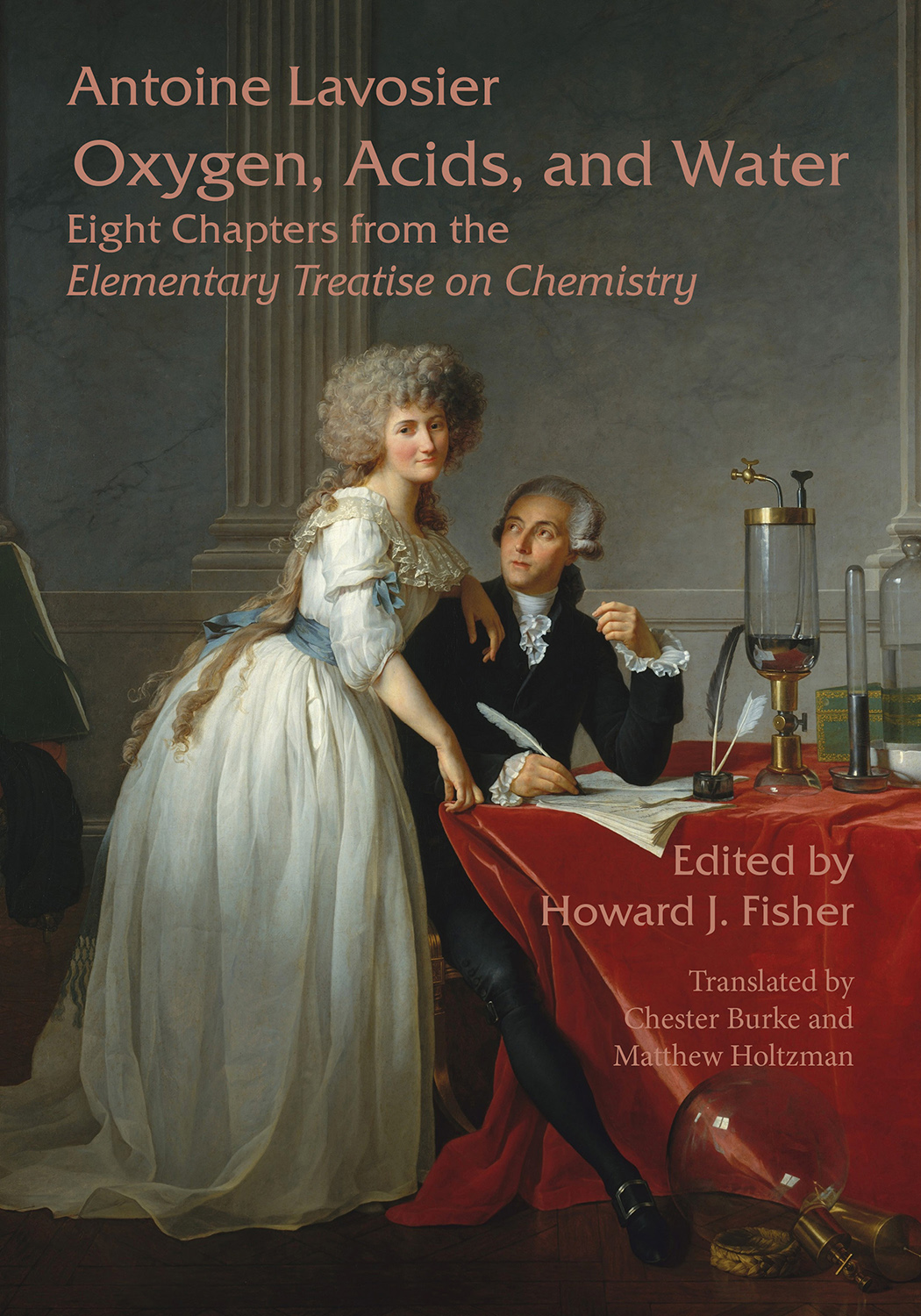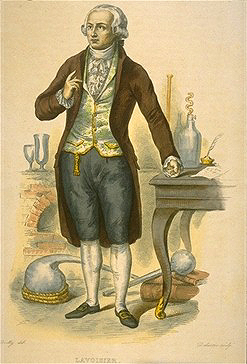Oxygen, Acids, and Water:
Eight Chapters from the Elementary Treatise on Chemistry
A Science Classics Module for Humanities Studies
by Antoine Lavoisier
Edited by Howard J. Fisher
New translation by Chester Burke and Matthew Holtzman
7 in. x 10 in., 120 pages, Table of Weights and Measures, Glossary of Names and Terms, Index.
Publication date, April 2019.
For pricing and ordering information, see the ordering section below.
 One of the most revolutionary scientific works ever written, and also one of the most accessible, Lavoisier's Elementary Treatise on Chemistry established the constancy of weight in chemical reactions, revealed the composition of water, and set forth a clear concept of the nature of gases. The Treatise cemented a new, rational nomenclature that accurately expressed the nature of materials, overthrowing such colorful but deceptive names as "flowers of sulfur" and "butter of arsenic." Impressed by Condillac's maxim, "the art of reasoning is, at bottom, nothing else but a well-constructed language," Lavoisier presents experimental facts in expressions that are vivid, exact, and often poetical. As a result, the Treatise is still, after more than 200 years, a model of clarity and a beautiful example of scientific reasoning.
One of the most revolutionary scientific works ever written, and also one of the most accessible, Lavoisier's Elementary Treatise on Chemistry established the constancy of weight in chemical reactions, revealed the composition of water, and set forth a clear concept of the nature of gases. The Treatise cemented a new, rational nomenclature that accurately expressed the nature of materials, overthrowing such colorful but deceptive names as "flowers of sulfur" and "butter of arsenic." Impressed by Condillac's maxim, "the art of reasoning is, at bottom, nothing else but a well-constructed language," Lavoisier presents experimental facts in expressions that are vivid, exact, and often poetical. As a result, the Treatise is still, after more than 200 years, a model of clarity and a beautiful example of scientific reasoning.
Lavoisier's magnificent work was last translated into English in 1790, in a style that even then could be considered wooden and excessively formalistic. Now Chester Burke and Matthew Holtzman, faculty members at St. John's College in Annapolis, have provided a rendition that preserves the natural and unadorned liveliness of Lavoisier's narrative prose.
Even more valuable to nonspecialist readers of this Green Cat Module is Howard Fisher's commentary, unobtrusively keyed to the text at the bottom of each page. For each word or phrase that is likely to be unfamiliar, Fisher gives a clear explanation. Obsolete chemical terms, physical concepts, archaic or obscure words, and unfamiliar references are fully explained. And, most important for those unable to repeat Lavoisier's experiments, Fisher lucidly describes the equipment and the procedures, and discusses the significance of the results. Readers who think, "Oh, this is science—I never could understand it," will be surprised to discover the clear and persuasive way that Lavoisier's beautiful language, assisted by Fisher's notes, brings this extraordinary and foundational work of science to life as human thought, and even as poetry.
Features
- Lavoisier's brilliant and comprehensible reform of chemistry, with notes explaining terms, measurements, equipment, and procedures.
- Original account of the discovery of oxygen, analysis and synthesis of water, and investigation of the nature of acids.
- Establishment of the principle of conservation of weight in chemical reactions.
- Development of modern chemical terminology, based on rational principles.
- Original engravings by Marie-Anne Pierrette Paulze Lavoisier, from the first 1789 French edition.
- New translation, bringing out for the first time in English Lavoisier's imagery and elegance of expression.
- Ideal for survey courses in humanities, history of science, and other general courses.
- No technical scientific knowledge or experience required. All experiments clearly explained.
Sample pages
Below are links to PDF versions of selected pages from Oxygen, Acids, and Water.
You may need to open these PDF documents in Adobe Reader or an equivalent program.
About the Author, Antoine Laurent Lavoisier (1743-1794)
 Lavoisier's accomplishments in chemistry were numerous and consequential; but central to them all was his appreciation of the importance of weight in chemical reactions—an insight which changed chemistry from a qualitative science to a quantitative one.
Lavoisier's accomplishments in chemistry were numerous and consequential; but central to them all was his appreciation of the importance of weight in chemical reactions—an insight which changed chemistry from a qualitative science to a quantitative one.
A quantitative science depends on measurement; and in the eighteenth century, instruments capable of precision performance were enormously expensive to build. Because Lavoisier had inherited a large fortune, he possessed the means to construct and maintain a large and sophisticated laboratory and furnish it with superbly-crafted scientific apparatus.
Lavoisier married Marie-Anne Pierrette Paulze in 1771. She was to become deeply involved in Lavoisier's scientific activities, assisting in the laboratory, documenting experiments and apparatus in sketches and notes, and translating the scientific writings of English researchers. It was she who prepared the engravings for the 1789 publication of the Elementary Treatise on Chemistry—engravings that are reproduced in this Green Cat Module.
Lavoisier's principal achievements and fame lay in the field of chemistry. Nevertheless, throughout his life he devoted substantial efforts towards social good, promoting improvements in agriculture, air and water quality, and public health.
In 1768 Lavoisier purchased a share in a company that collected customs, excise, and other taxes under royal charter. Although the income from this source helped finance his scientific work, Lavoisier's association with tax collection later made him a target of the revolutionary powers; he was put to death on 8 May 1794 at age 50.
The mathematician Lagrange memorialized Lavoisier's execution with these words: "It took them but an instant to cut off this head, and one hundred years might not suffice to produce another like it." A year and a half after his death, Lavoisier was exonerated by the French government.
